Are you wondering, “What are some of the best gardening hacks?” These 33 brilliant gardening tips & ideas are so simple, but make a huge impact! Try a few of these vegetable gardening hacks this year, and be amazed by the results.
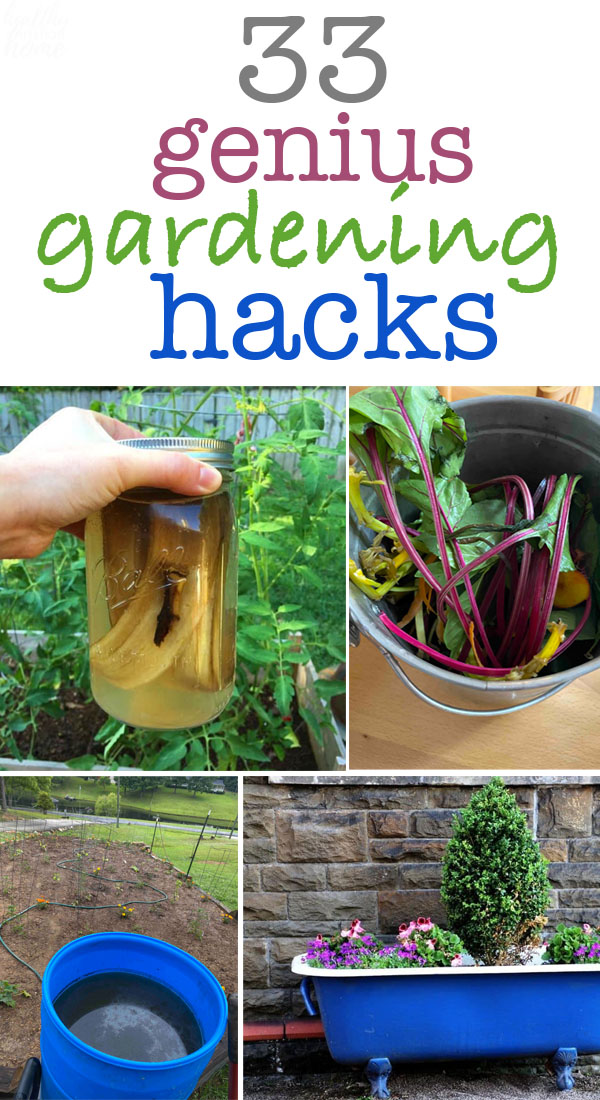
Starting a Garden is Fun!
Our first summer as newlyweds, my husband rose early every summer morning to putter around in the garden. I had no idea what he was doing then, all I knew was the tomatoes and peppers were some of the best I’ve ever had. My salsa recipe was perfected thanks to that garden. Since then, I’ve had a huge respect for anyone with a green thumb.
Thankfully, my husband (who is a masterful gardener) helped me with the gardening ideas in this post. He grows the food, I cook it, that’s our deal. There are lots of gardening hacks for beginners too, so if you’re inexperienced at gardening, these tips will be very helpful.
How do you get good at gardening? What are some gardening tips for beginners?
Honestly, if you’re a beginner gardener, a lot of learning is trial and error. Of course, it’s helpful to read a couple books and try some of the hacks below. Here’s a great post on the basics of planting a successful veggie garden.
One of the best ways to get good at gardening is to just choose a couple of plants to grow your first year. Then, see what happens, learn, and expand next year.
Also, ask for help. Gardening is a great way to form community. My husband asked some of the older people in our church to help him learn how to garden, and they were a wealth of knowledge!
They even came to our house, brought a tiller and some plants, and showed him how to get started. Don’t underestimate the power of wisdom passed down from your elders — it will make their day to know you asked their advice, too.
33 Gardening Hacks You Must Try This Season
I hope you enjoy all the gardening tips he has to share, plus a few others from friends around the web. If you’re looking for summer gardening tips, you’ve come to the right place!
1. Plant marigolds around your vegetable garden to prevent pests organically.
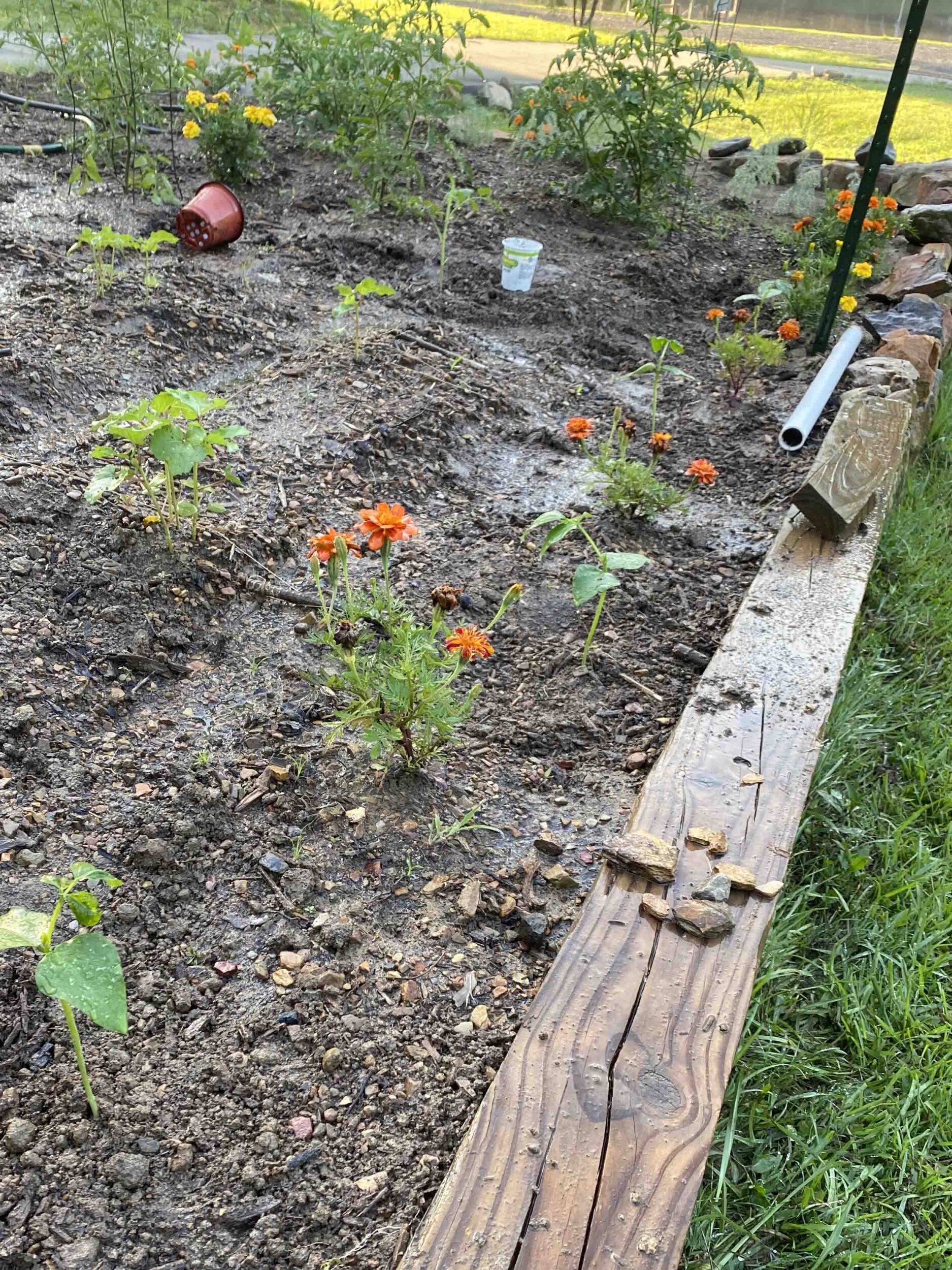
Marigolds have a pungent scent that can help keep pests away, and they also produce chemicals underground that kill root nematodes. Even better, they attract helpful insects who prey on the bad bugs. They also bring bees and butterflies to your garden.
Marigolds are especially helpful if you’re into organic gardening and try to avoid chemicals and herbicides. My husband plants marigolds all around the perimeter of our vegetable garden each year.
2. Cardboard underneath soil to smother weeds and prevent them from growing.
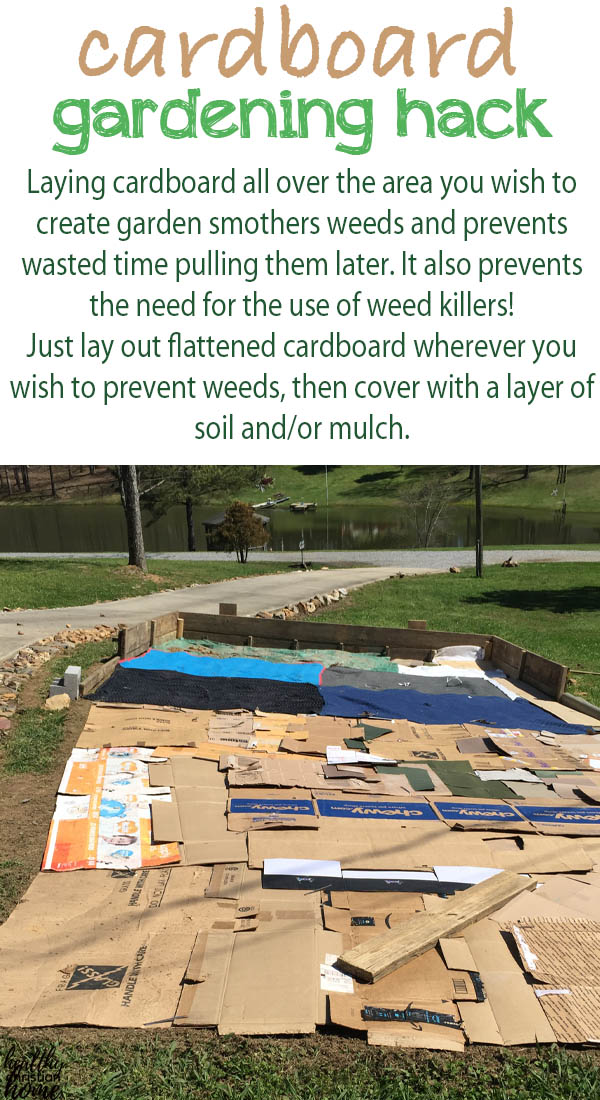
Laying cardboard all over the area you wish to create garden can smother weeds and prevent a lot of wasted time pulling them later. It also prevents the need for the use of weed killers!
Just lay out flattened cardboard wherever you wish to prevent weeds, then cover with a layer of soil and/or mulch. It can also be helpful in killing lawn grass, if you have an area you wish to convert into a veggie garden.
3. Use Eggshells for nourishment (and more).
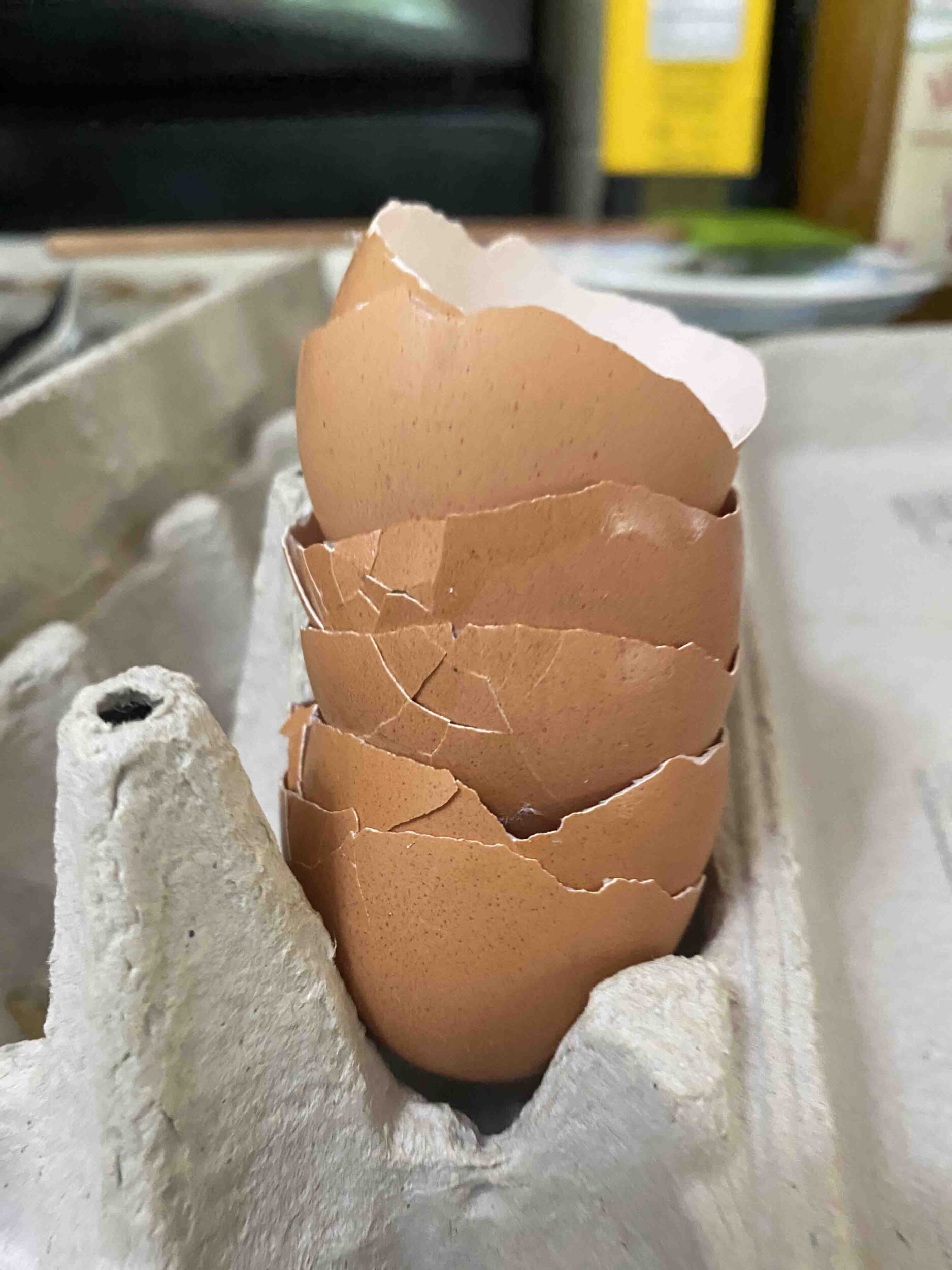
Never throw away your eggshells! They are useful for gardening in several ways:
- At the beginning of the season, you can actually use them to plant seedlings then transfer the whole thing to the garden later.
- To fertilize and nourish the soil, crushed eggshells are a great source of calcium!
- Soak eggshells in water for several days and use the calcium rich water for plants.
- Or, crush them into small pieces and sprinkle them around the garden as a pest control method. Eggshells act as a barrier, because the bugs and slugs don’t like crawling across the sharp, jagged surfaces.
4. Use coffee grounds as fertilizer.
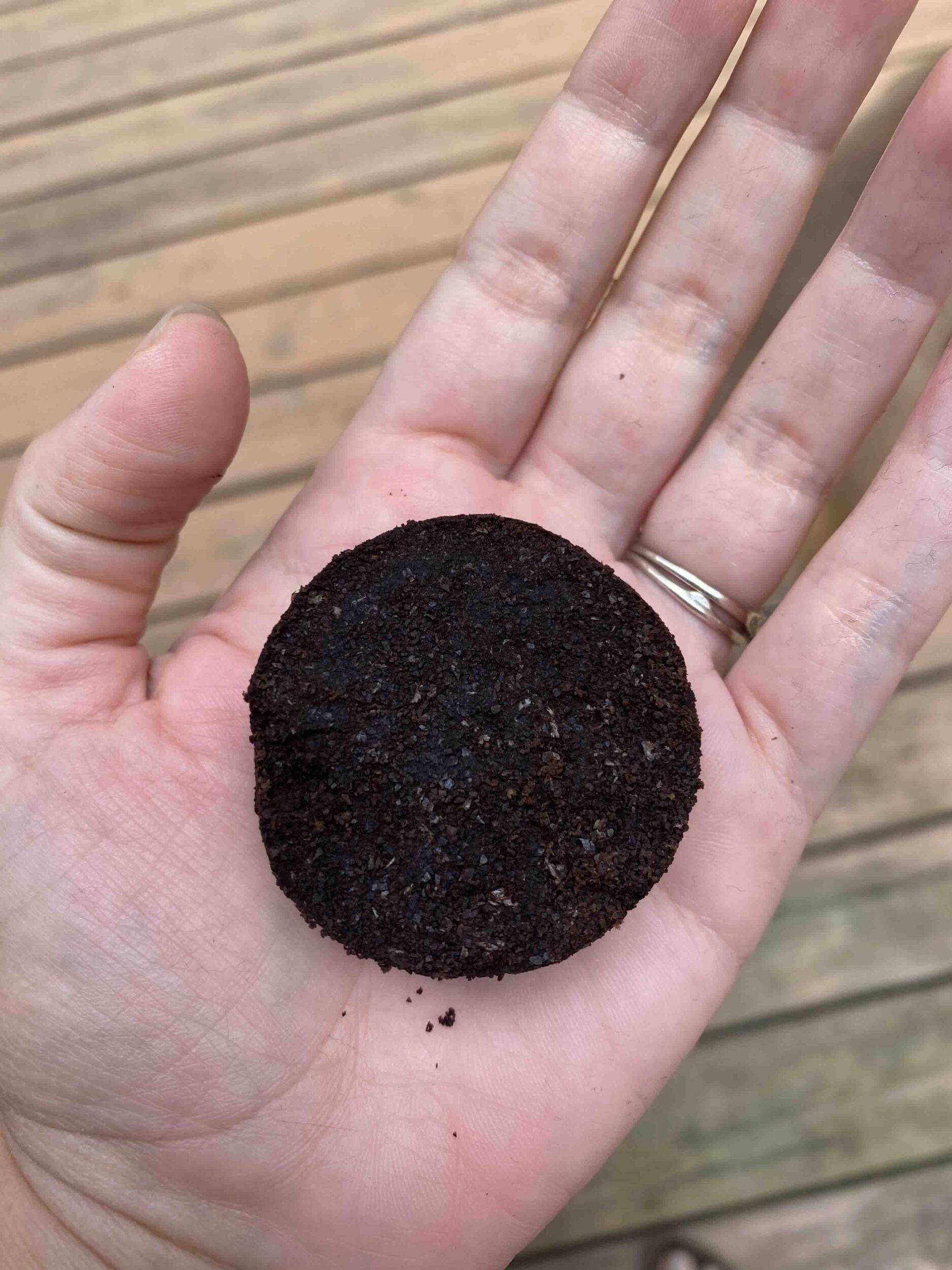
Coffee grounds contain lots of great nutrients for your soil to help nourish your plants! They are a good source of nitrogen, along with phosphorous, potassium and more. Worms apparently love them too. Some say coffee grounds also help prevent pests like slugs, snails, ants, etc. since it may be harmful to them. Couldn’t hurt!
5. Save your cooking scraps to use as compost fertilizer.

There are so many food scraps that we normally throw away, which can be used to improve the health of your garden and fertilize the soil. Basically any organic food matter can be used, with the exception of meat & dairy products. Great options include veggie & fruit scraps, eggshells, bread crusts, grains, etc. Keep a simple compost pail on the counter to collect all your scraps while you cook.
6. Use a compost “tumbler” to improve the quality of your compost.
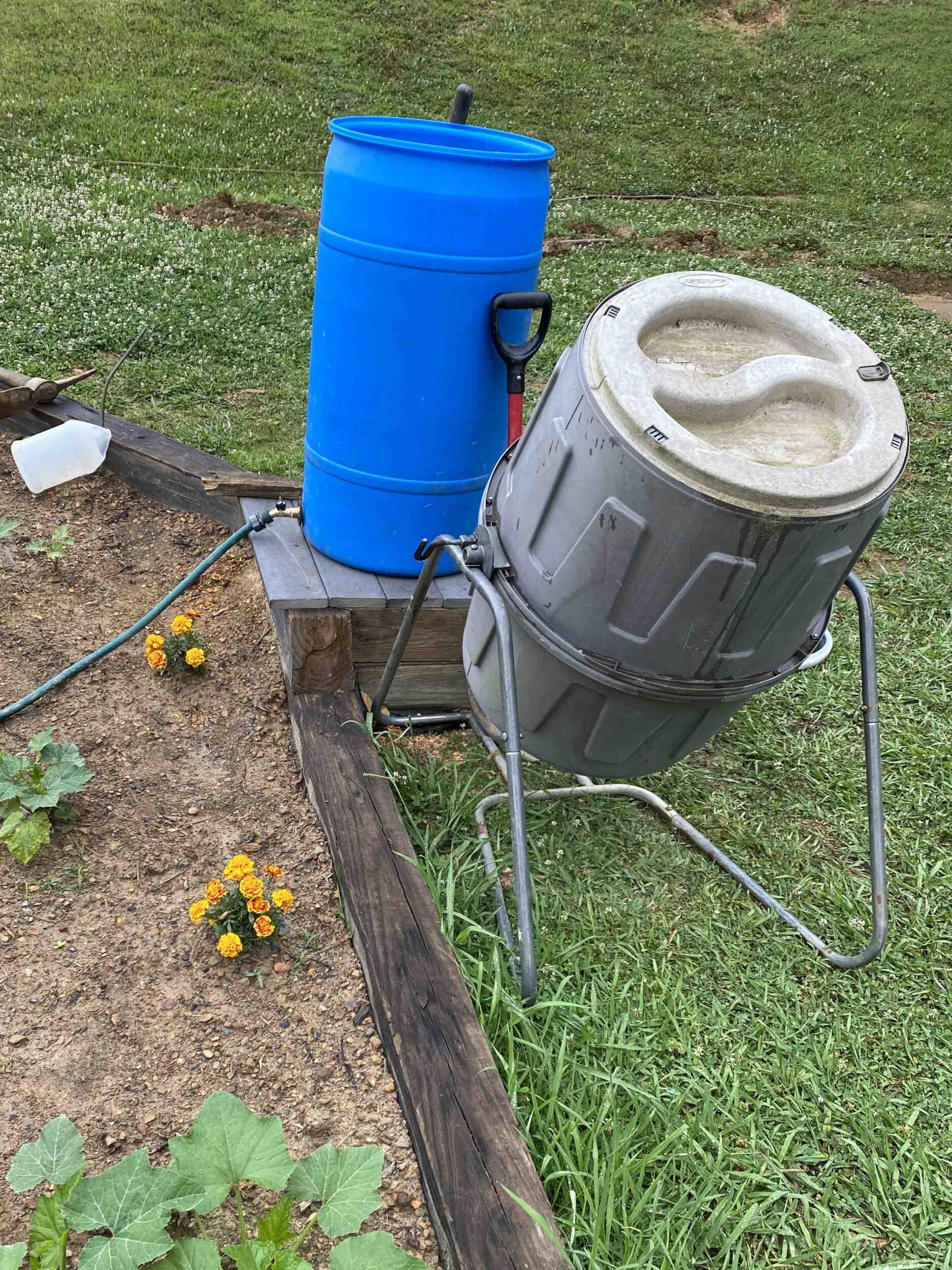
A compost tumbler helps aerate your compost and is great for depositing all your cooking scraps. We were given one by a friend, but you can purchase one. We added some bagged composted soil which acts like a starter, and also add worms from the garden after a rain.
Every day, our boys turn the tumbler which provides the oxygen the compost needs to be broken down. The worms do their job as well. If you do not turn your compost, it will heat up due to the breakdown process and will not create a good final product. You can even do this by hand with garden tools, but a tumbler makes it really simple.
7. Banana peel potassium “tea” for plants.
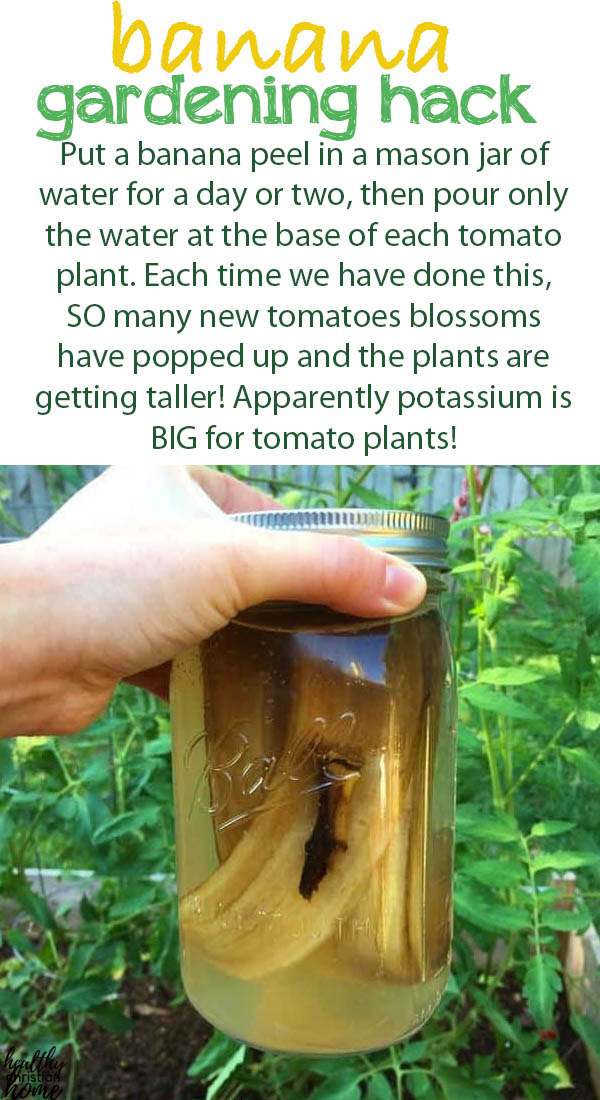
Put a banana peel in a mason jar of water for a day or two, then pour only the water at the base of each tomato plant. Each time we have done this, SO many new tomatoes blossoms have popped up and the plants are getting taller! Apparently potassium is BIG for tomato plants! (This tip is from my friend Ansley — her new blog is Our Joy in the Journey.)
8. Make a mixed compost tea to pour around the garden.
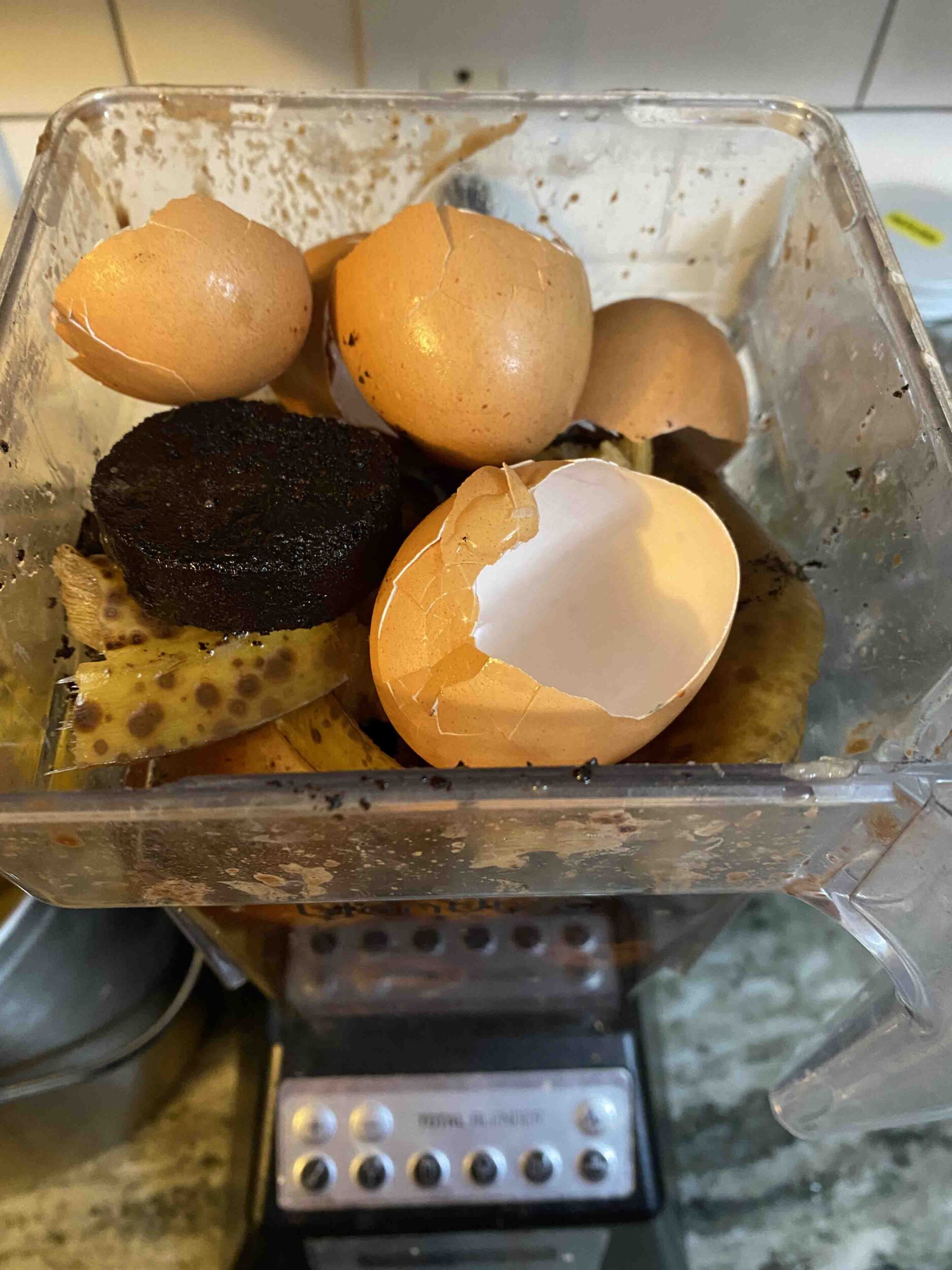
If you’re saving eggshells, coffee grounds, and banana peels, here’s another idea. Throw them all in the blender with a few cups of water and blend it into a compost tea. We have a heavy duty Blendtec blender that handles the egg shells well. Dilute with water, and pour this mixture around the garden to fertilize plants.
9. Create a compost tea system
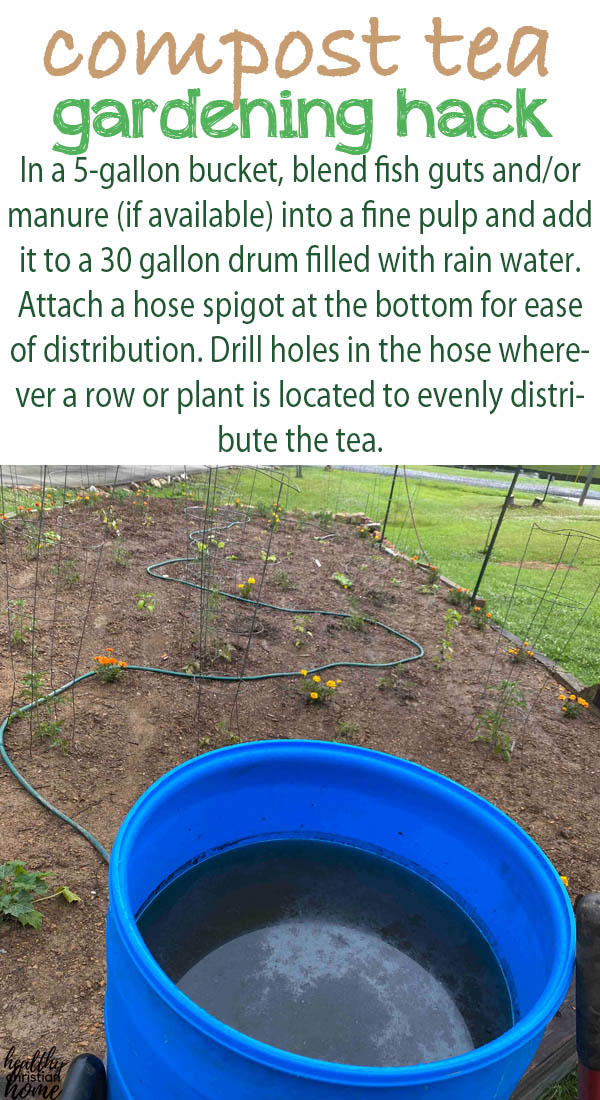
Compost tea is not something you would want to drink, but it is something your garden will enjoy! To make compost tea I recommend using a sealable container outdoors. In a 5-gallon bucket, blend fish guts and/or manure (if available) into a fine pulp and add it to a 30 gallon drum filled with rain water.
The container has a lock seal lid, so your neighbors do not get annoyed by the smell. Attach a hose spigot at the bottom for ease of distribution. Our hose is the length of the garden and capped off at the end, and I drilled holes in the hose wherever a row or plant is located to evenly distribute the tea.
10. Know when & how to prune your garden.
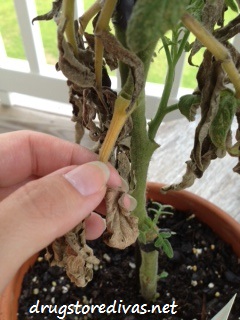
Pruning your garden will really improve the health of your plants. It’s actually very simple! Simply pull off any dead leaves or stems, or any that are yellow or snap off easily. This will give the plant more resources to send to the healthier leaves, flowers, and fruit. via Drugstore Divas
11. Protect your garden from frost.
Knowing how to protect your garden from frost, which plants to protect, coverings to use, and creating micro-climates are all really helpful for the beginning and end of the season! via Learning and Yearning
12. Know which companion flowers to plant with your vegetables.
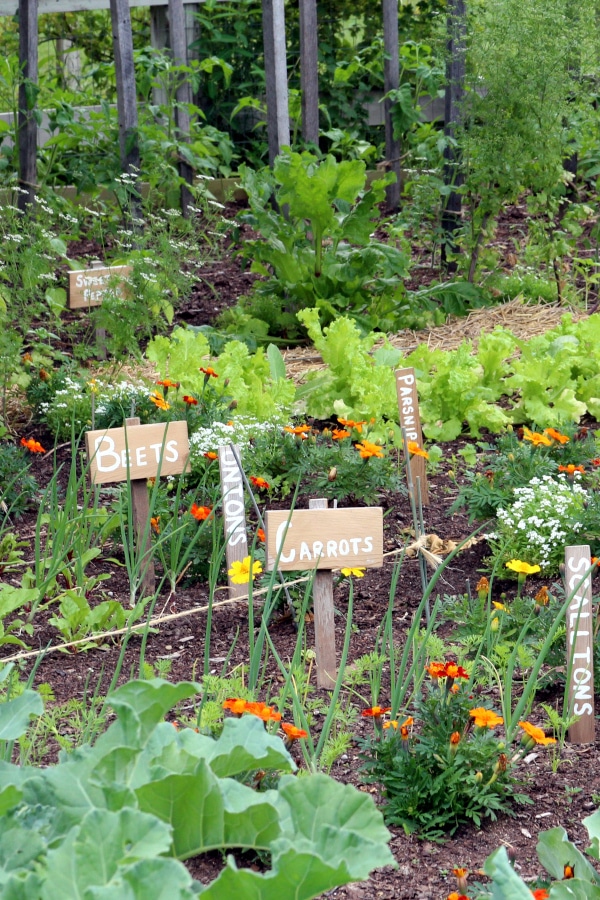
Did you know you can grow a healthier vegetable garden with companion planting? Try adding flowers with these vegetables for great results! via Lavender HomeFront
13. Incorporate fast growing veggies for a quicker yield.
Do you struggle with patience while gardening? Me too. Here are 15+ of the fastest growing veggies you can be eating in 30 days or less. via Mr. Animal Farm
14. Make “seed bombs” to protect your seeds while they germinate.
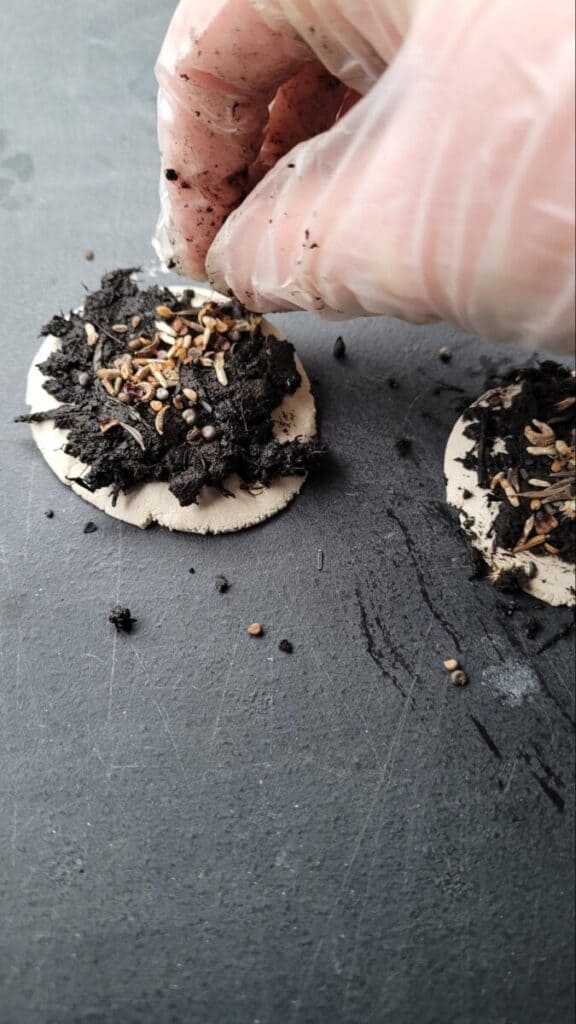
Keep your seeds safe from birds or from drying out while they germinate with DIY seed bombs. They’re also a great way to get kids excited about gardening! via Hessun Academy
15. Turn an old pallet into an herb garden.
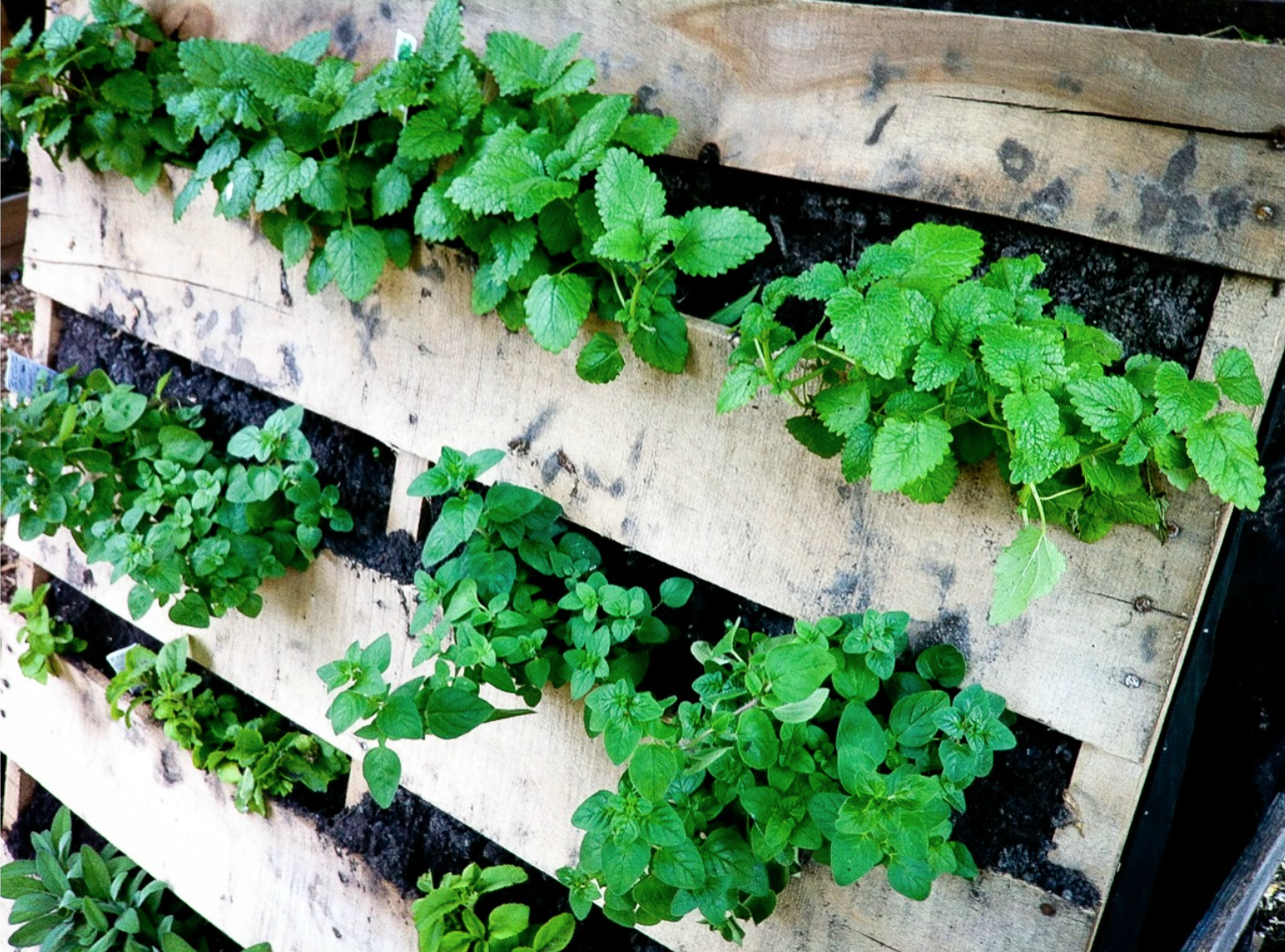
Need some fresh herbs to go along with all the wonderful vegetables you’re growing? Take an old pallet and turn it into a beautiful herb garden by following these steps. via Jen Around the World
16. Make DIY vegetable garden markers.
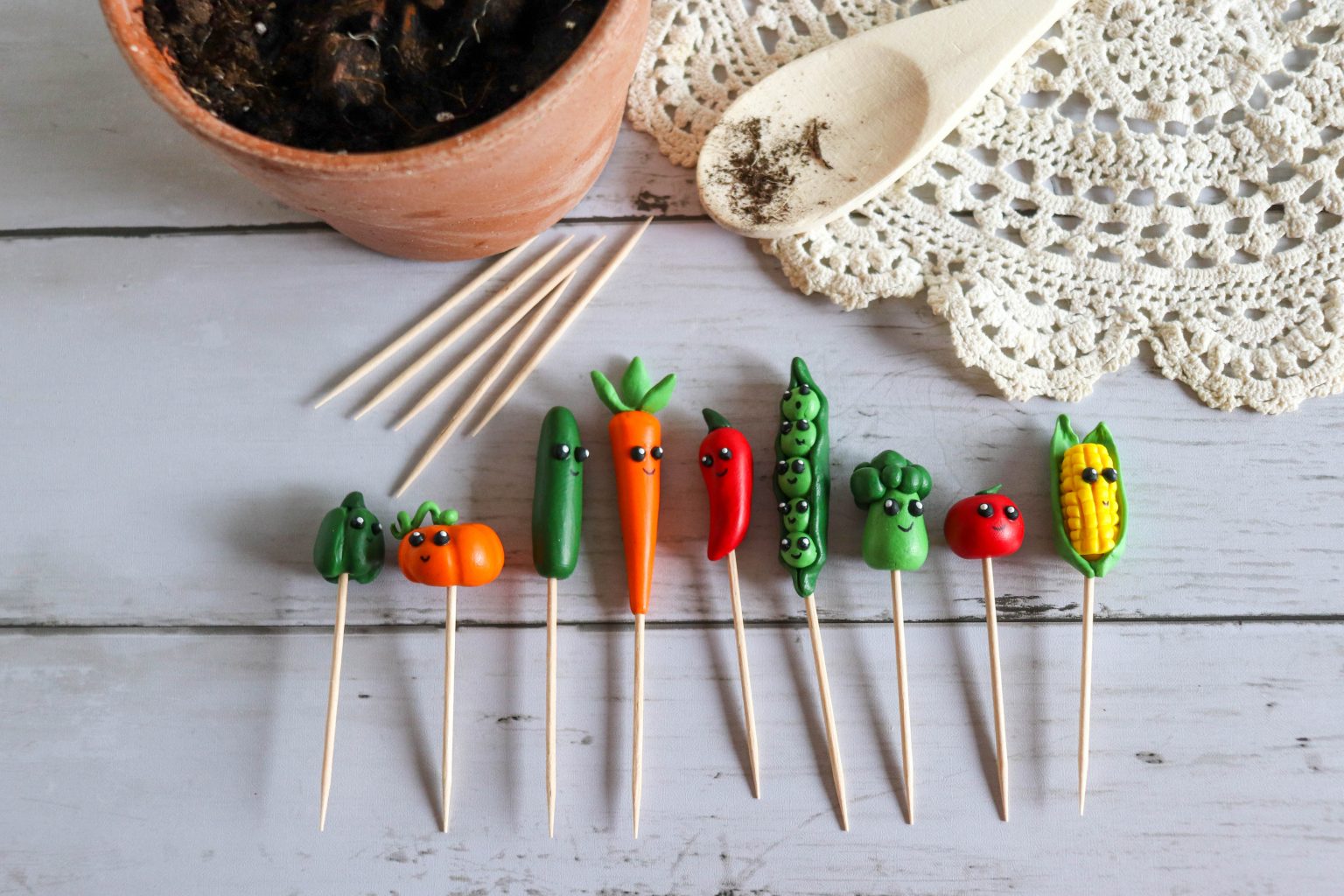
These DIY clay vegetable garden markers are fun to make and perfect for identifying seeds that you have planted in the garden this spring. via Homemade Heather
17. Or, make garden markers out of large rocks.
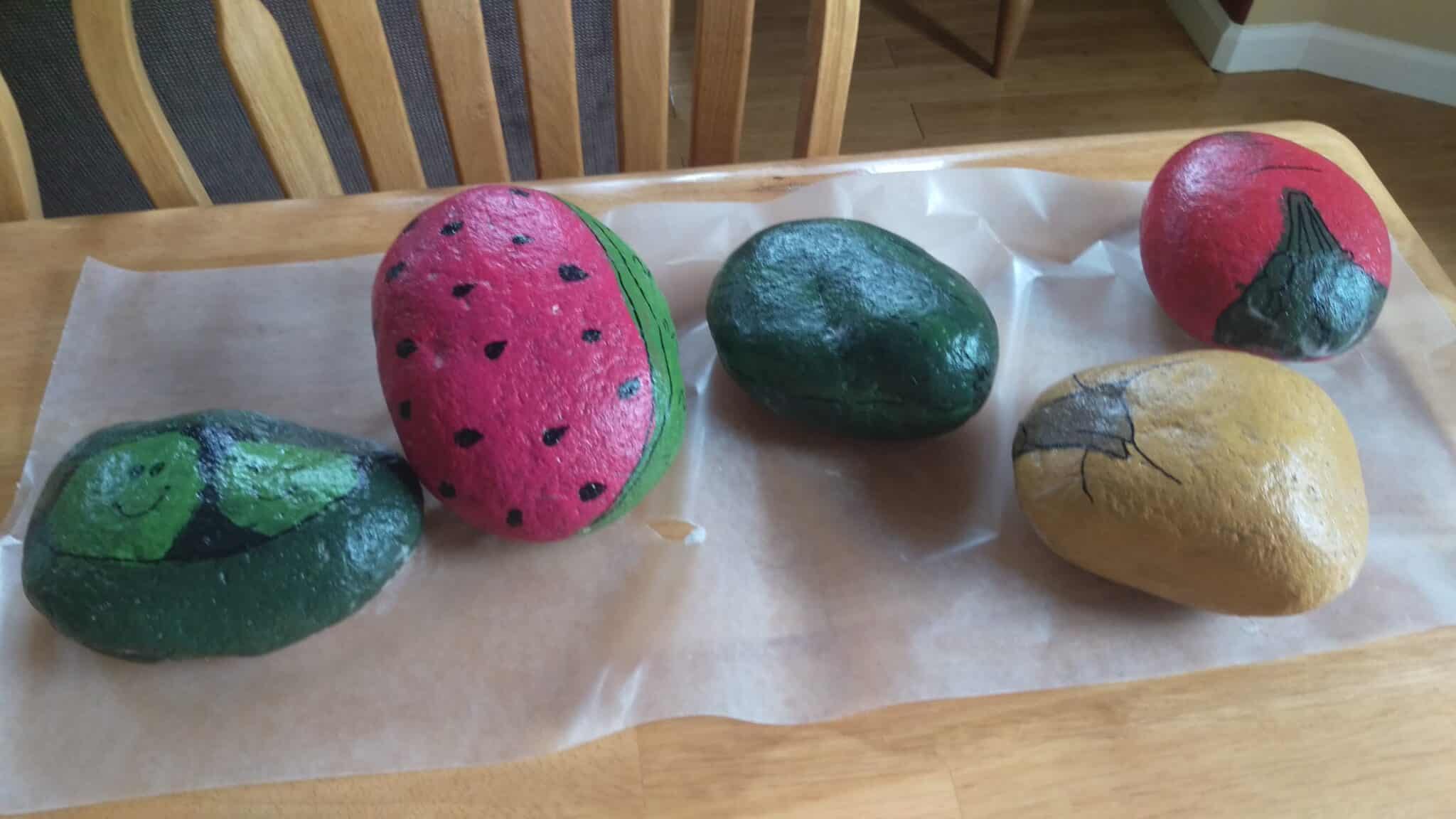
Learn how to make these DIY plant markers and get ideas on how to create your own with garden river rocks, modge-podge-and paint! via Saving Talents
18. Use weeds to make a nourishing liquid compost for your garden.
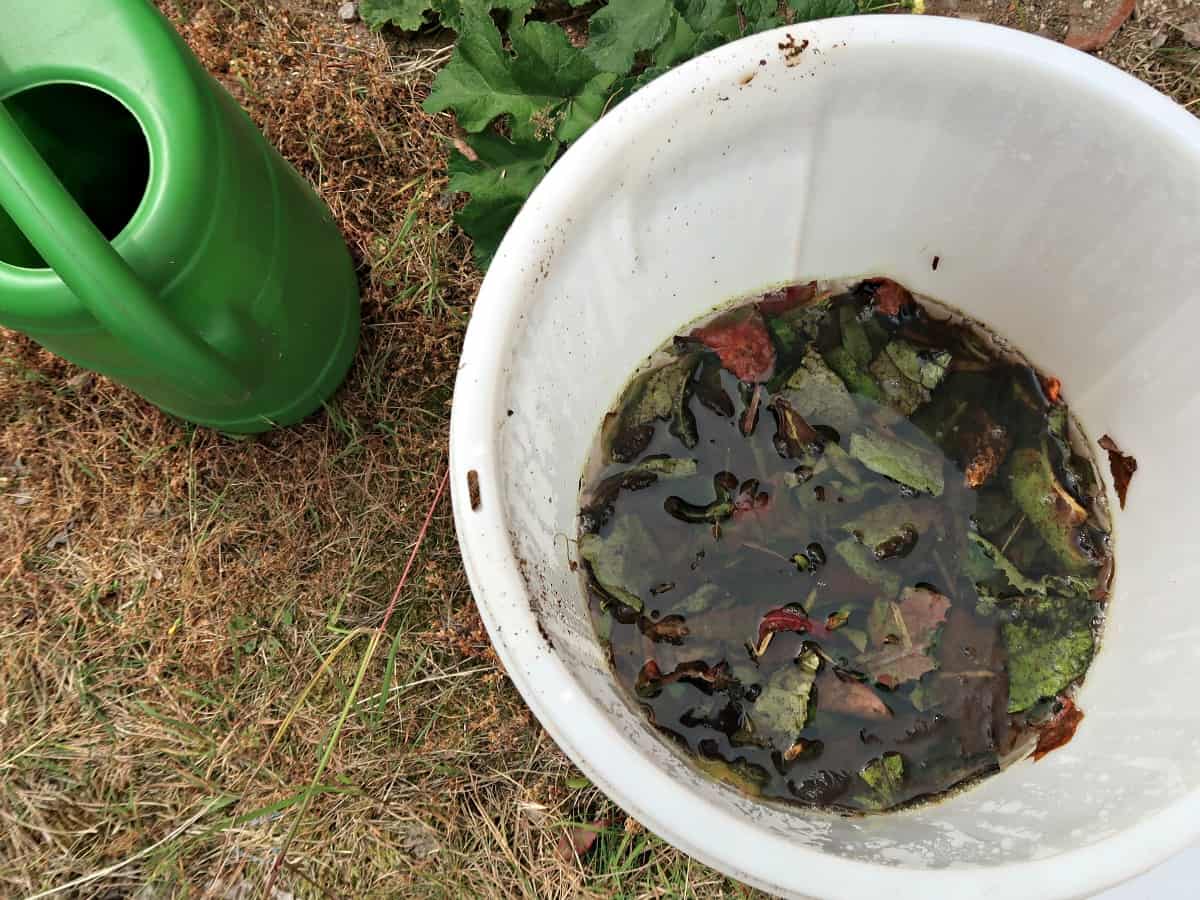
Quick, easy and free to make, using a liquid compost made from weeds on your vegetable garden will ensure a bumper crop and nutrient-dense vegetables for your table. via Craft Invaders
19. Make a simple herb garden using recycled containers.
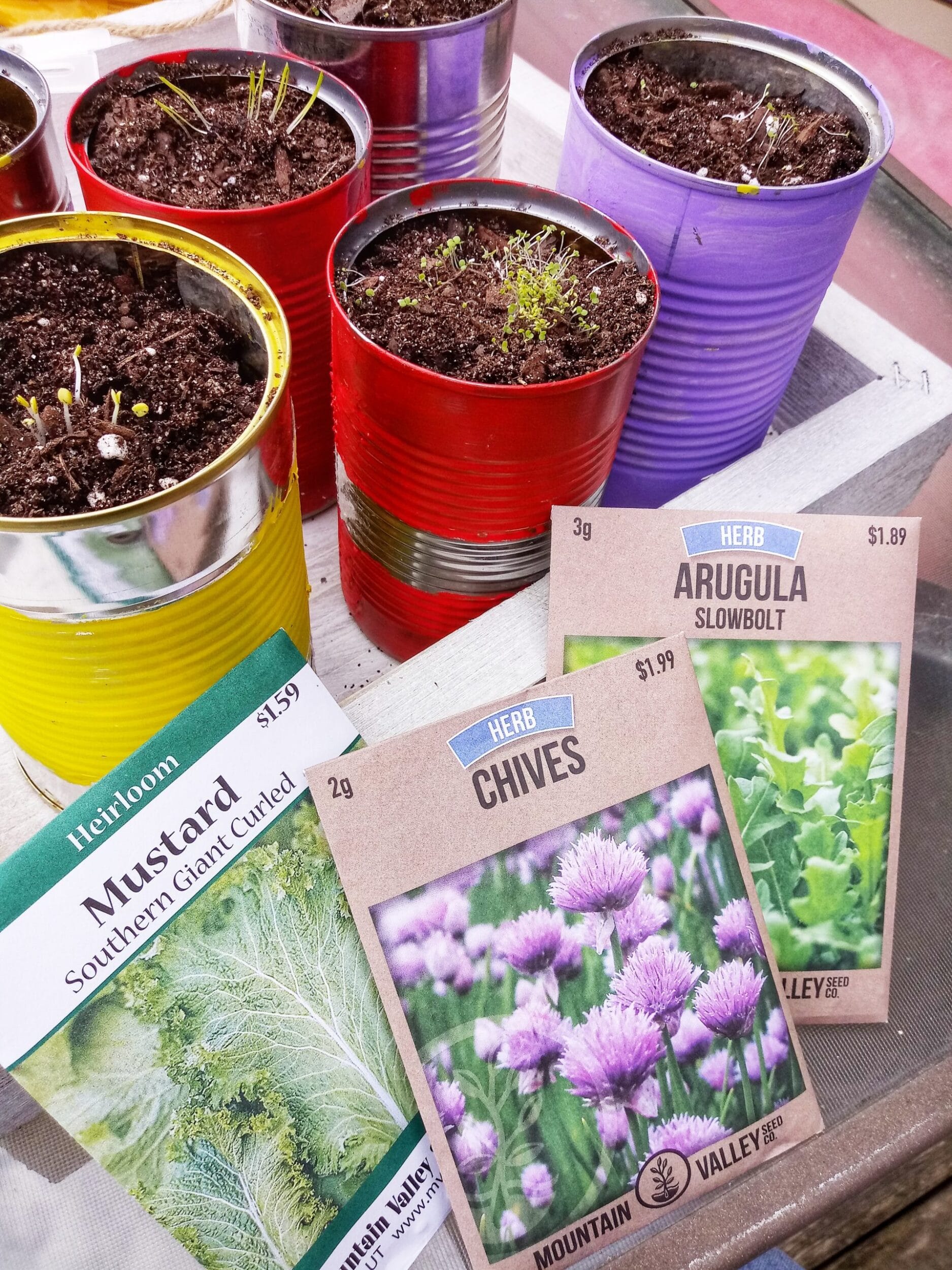
Recycle tin cans to start a simple herb garden (this is a great project to do with kids). Simply removed the labels and poke several holes in the bottom for drainage. via Two Kids & a Coupon
20. Use milk jugs for winter sowing seeds.
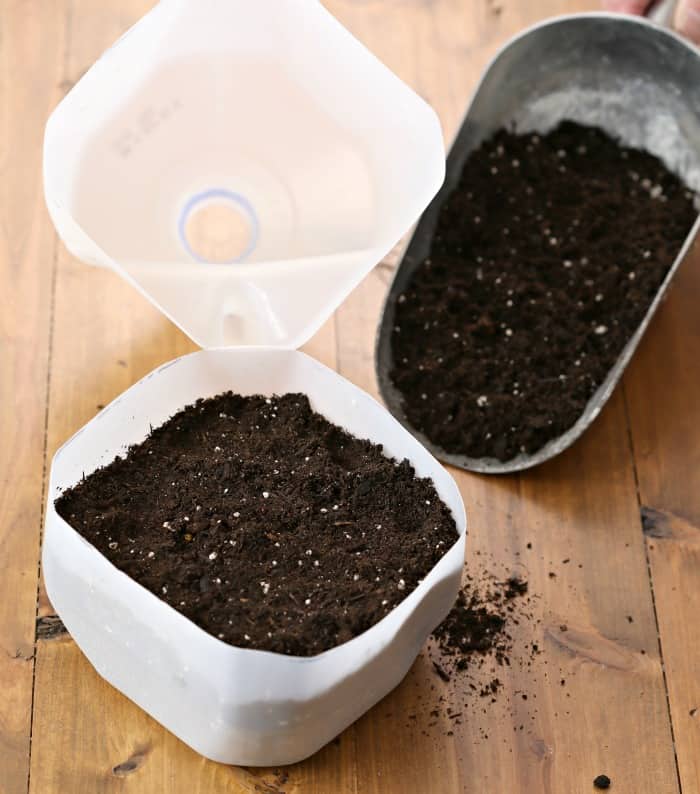
Winter Sowing seeds in milk jugs is a great way to start vegetables, perennials, and annuals. Of all the seed starting systems, this is by far the easiest and most budget friendly! via Plant for Success
21. DIY Seed Starter Pots from Toilet Paper Rolls
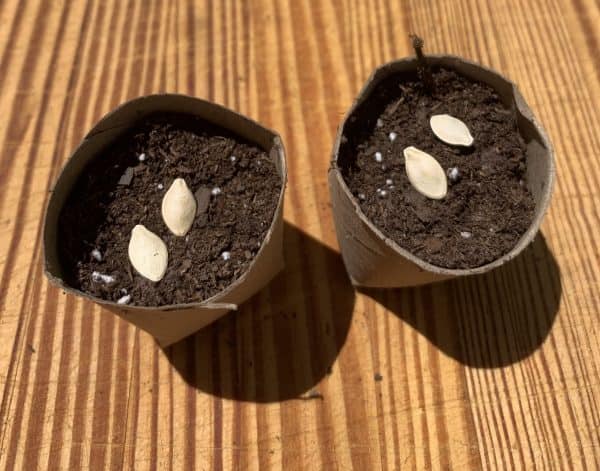
Sometimes you need to start seeds indoors before you can plant them outside. Instead of wasting money on expensive seed starting pots, discover how you can easily transform toilet paper rolls into DIY seed starter pots. via Earth Friendly Tips
22. Or, make seed starting pots from newspaper.
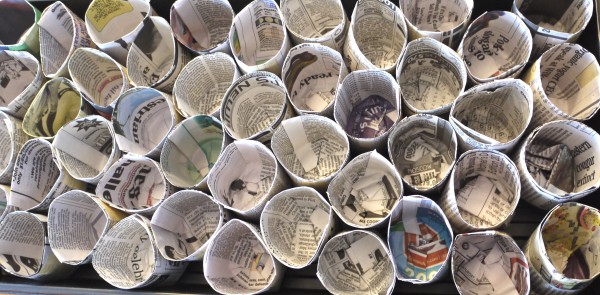
These seed starting pots from newspaper are a great way to both recycle and to reduce your use of plastic! via Learning & Yearning
23. Try these Dollar Tree greenhouse seedling starters.
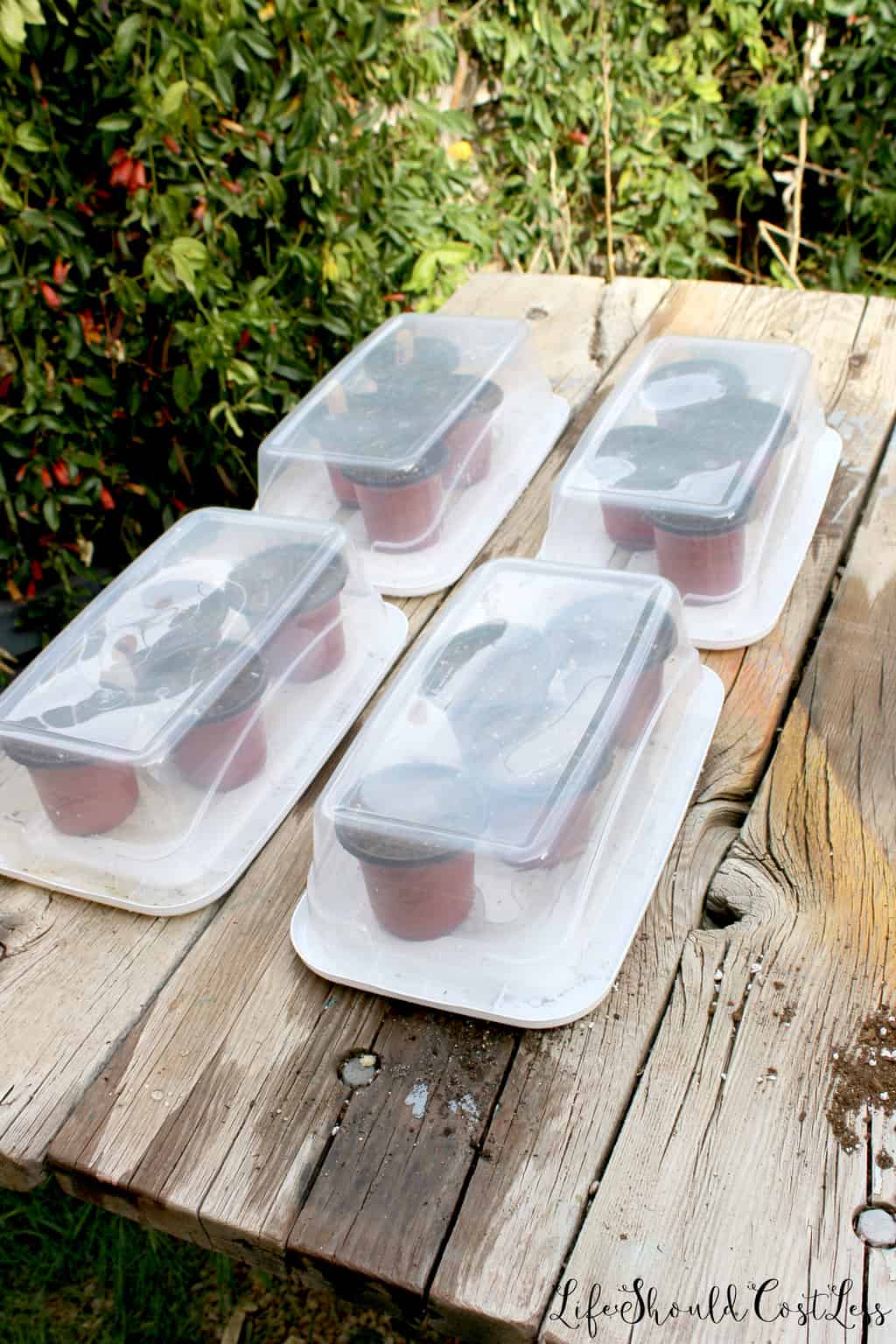
You can make a personal mini greenhouse to start seedlings using plastic bins and supplies from the Dollar Tree. This is a great activity for kids. via Life Should Cost Less
24. Use vinegar or boiling water to kill weeds.
For a non-toxic solution for getting rid of weeds, try pouring distilled white vinegar or boiling water into the weeds you want to kill. Just be careful not to get any near the plants you are trying to grow!
25. DIY bean pole tower
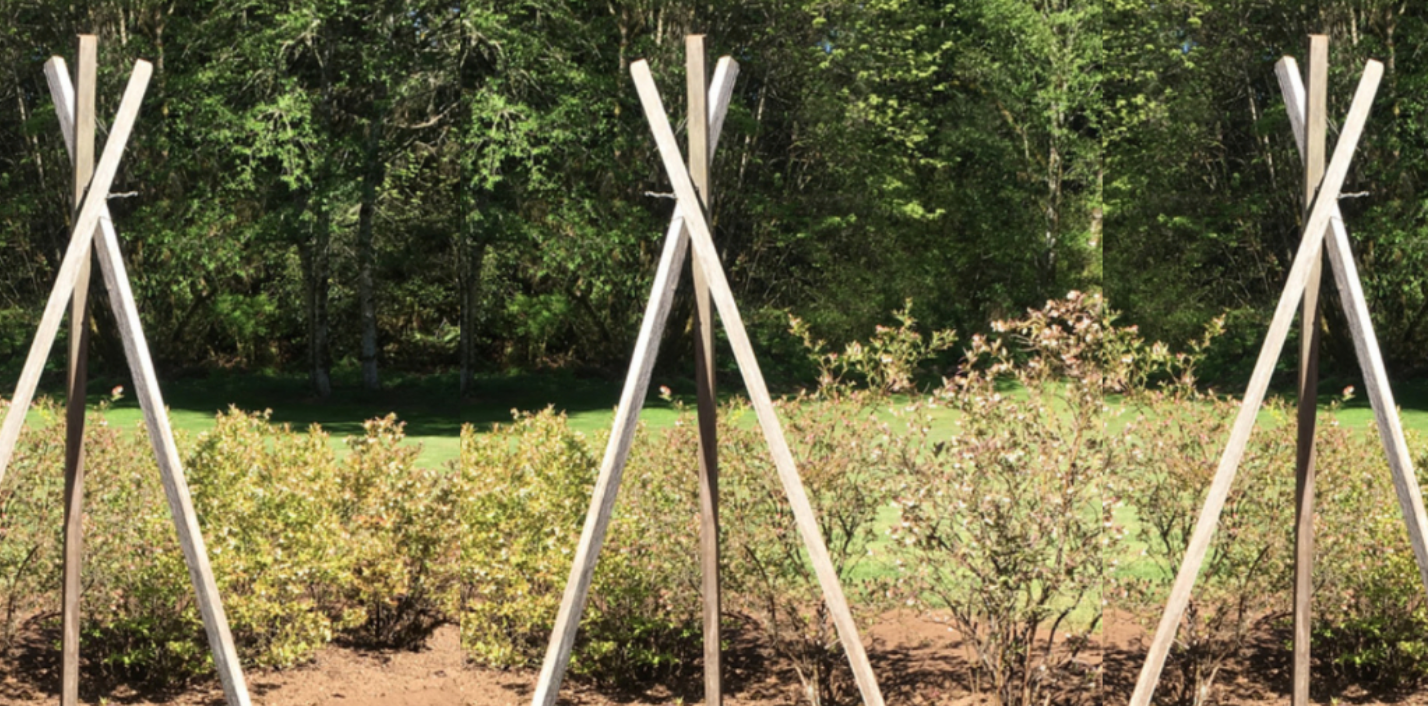
This easy DIY pole bean tower is a fabulous vertical accent piece fir a vegetable garden. Made of simple materials, it folds for easy storage in the off-season. via Fluxing Well
26. Try container gardening.
Not ready to take on a full size garden? These plants are perfect for container gardens on your porch, patio, or deck! via Coastal Wandering
27. Regrow food from scraps.
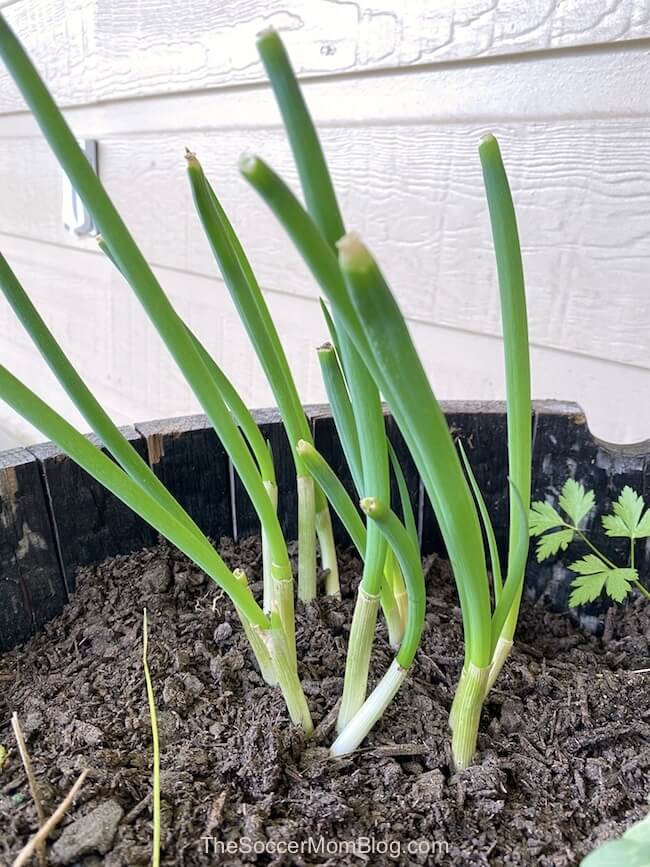
If you’re a total beginner, why not try a garden experiment in your own kitchen? There are lots of foods you can regrow from scraps — it’s easy, free, and you don’t need a lot of space! Here’s a list of 15 plants to grow from scraps to keep fresh produce ready all year long! via The Soccer Mom Blog
28. Make comfrey tea fertilizer.
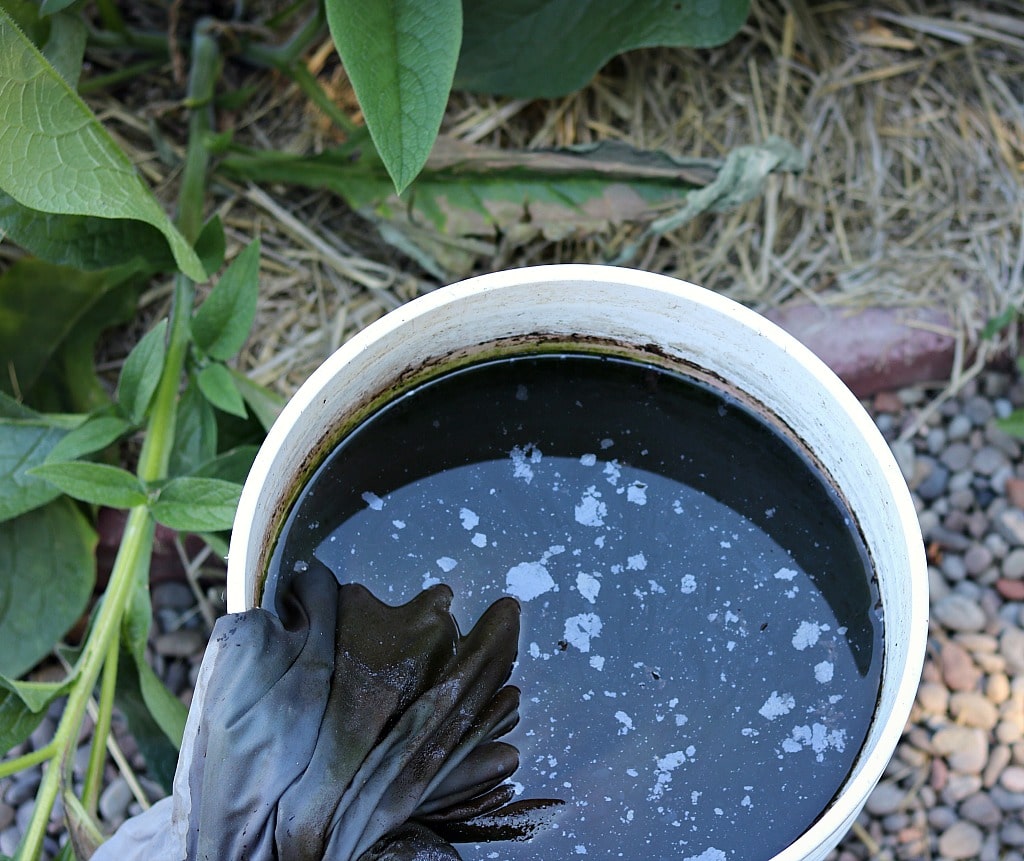
Try this DIY, chemical-free, all-natural fertilizer made with comfrey plants! It’s so easy to make and is an effective alternative to conventional fertilizers. via Grow Forage Cook Ferment
29. DIY Grow Light for Seed Starting
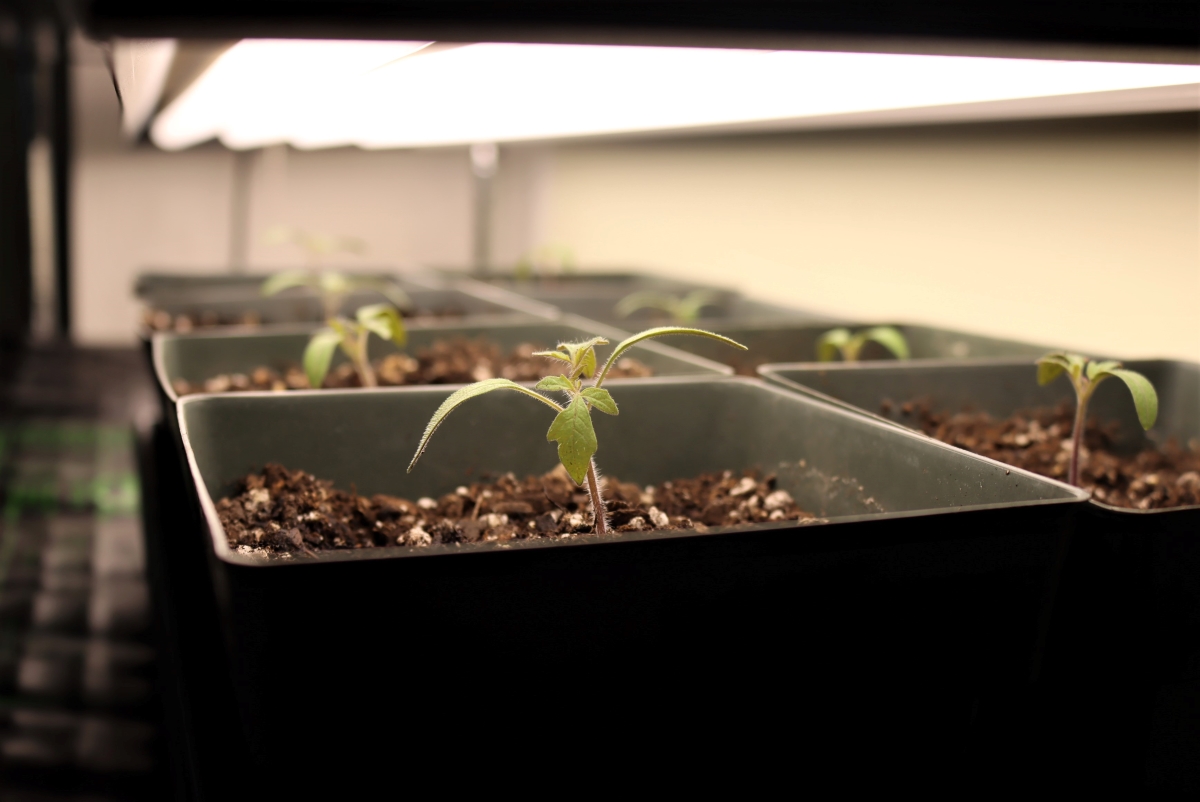
Instead of buying expensive grow lights, why not make your own? These DIY grow lights get the job done for a fraction of the cost of the store-bought versions and are so easy to make. via Practical Self Reliance
30. Create a small space garden spiral.
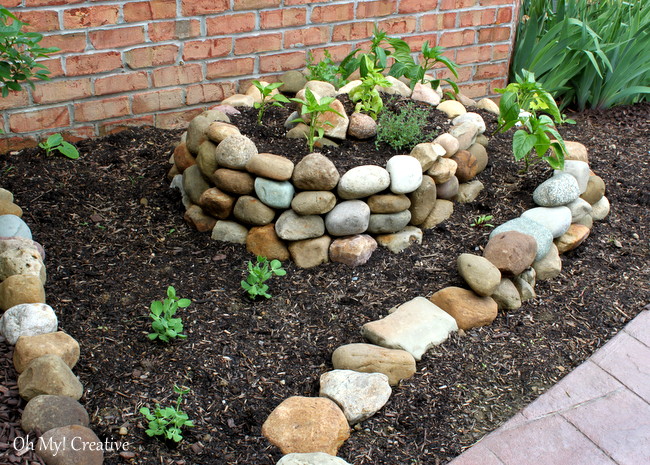
Transform your small garden space by creating a garden spiral out of stone. It expands your garden space, and looks like a work of art! via Oh My Creative
31. Use Upcycled Plant Containers
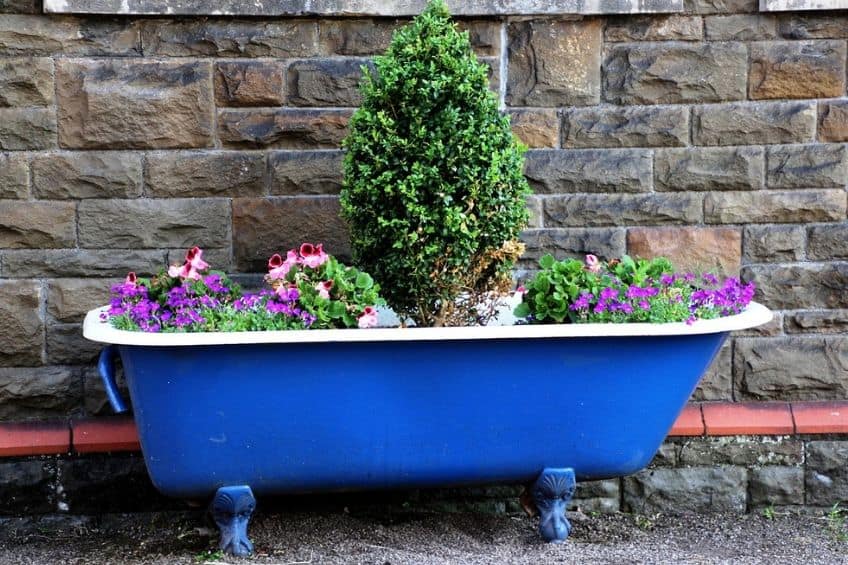
To spice up the look of your garden, why not use creative upcycled containers? Upcycling household items like bottles, cans and jars into planter pots is a great way to make use of items that would otherwise be thrown in the trash. via Urban Garden Gal
32. Build your own raised bed garden.
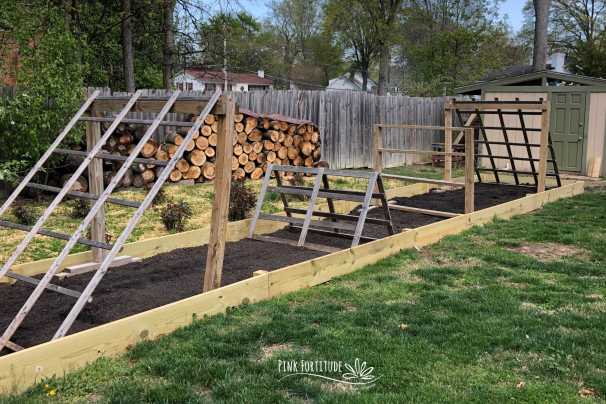
In just a few hours, you can build a new raised bed garden. It’s actually more of a built-in and raised bed hybrid. But it gives the vegetables plenty of space for the roots to be happy and flourish. If you ever wondered how to build a raised bed garden, this is your DIY! via Pink Fortitude
33. Use newspaper as a cheap way to prevent weeds
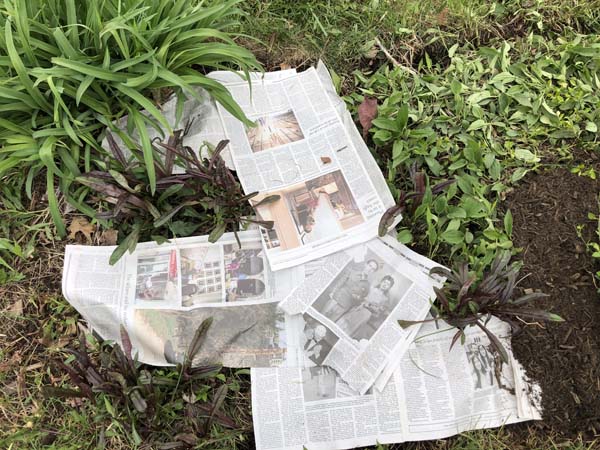
Newspaper is a natural way to stop weeds in your garden and flower beds without chemical herbicides. Simply cover with mulch, and you’re done! via Needle Pointers
What are your best gardening hacks to add to this list? Please add your ideas below!

Hi Mary – I love all of these garden hacks. PINNED! I’m totally doing the banana peel one with my tomatoes! Thank you for including my raised bed garden. My heart is full of gratitude. Blessings and hugs, Holly
Aw, you are so sweet Holly! So happy to include your raised bed garden!!